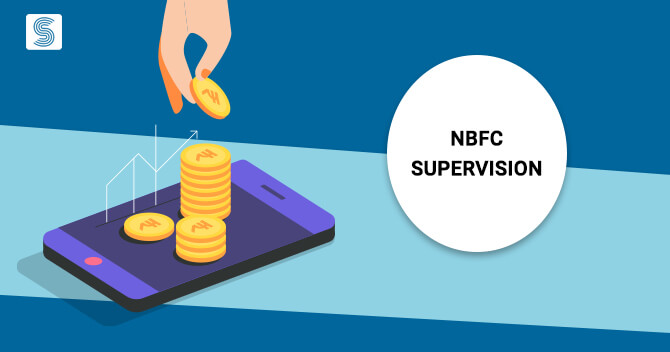Effects of COVID-19 on NBFC Sector in India

Shivi Gupta | Updated: Jun 13, 2020 | Category: NBFC, RBI Advisory
This article talks about the pre-coronavirus NBFC sector, the effects of COVID-19 on NBFC and the measures which can be taken by NBFCs in India to manage the coronavirus impact on financial services.
The COVID-19 pandemic has severely affected global economies and has had a significant effect on the financial sectors worldwide, including the Indian financial sector. The wildfire spread of the coronavirus across the world and the following lockdowns and travel advisories have resulted in grave cash flow issues for many business sectors in India, including the Non-Banking Financial Company (NBFC) sector. The impact of COVID-19 on NBFC sector has created numerous issues for the private lenders and other non-banking institutions in India. The problems faced by the NBFCs have resulted from the highly unpredictable market that has been created due to the halt in the Indian economy.
Table of Contents
Pre-Coronavirus NBFC Sector in India
India has emerged as one of the fastest developing economies in the world. The recent growth trends in the Indian economy have proven India’s grit to renovate its industries, including the financial industry of the country. The advent of Non-Banking Financial Companies – NBFC in India has had revolutionary effects on monetary transactions undertaken by businesses as well as individuals.
NBFCs in India redesigned several financial processes, streamlined financial solutions for the masses and reached out to a large market of individuals and enterprises which were yet to receive proper financial assistance.
NBFC entities proved to be the right partner for the Indian banks through their ability to serve an enormous unserved market that had been waiting for financial services and was unreachable by banking organisations. NBFCs leveraged technology-focused their services to a niche market and extended quality loan products.
In the pre-COVID-19 era, NBFCs in India were emerging as the new-age financial institutions with the ability to provide customised financial assistance to the masses. NBFCs targeted those geographical locations, where banks were unable to provide their services.
Indian NBFCs were also able to create a large market for themselves in the form of small and medium enterprises, low-income earning individuals and self-employed professionals. This market was unable to avail banking services due to their limited credit history or a lack thereof.
Additionally, NBFCs in India before the coronavirus age were a source of constant credit flow and revenue generation in the economy. The sector was favoured by the masses for their financial needs due to the flexible and more approachable services offered by NBFCs.
Effects of COVID-19 on NBFC Sector
The current global crisis of COVID-19 has created an array of problems for all kinds of businesses. The novel coronavirus has posed various challenges to the NBFC sector, which was recovering from the liquidity crisis in India. The numerous effects of COVID-19 on NBFC sector in India can be summarised as follows:
Restriction on Classification of NPA
As per the RBI directions for providing relief to borrowers in India, a moratorium till June 30, 2020, has been applied on the repayment of loans extended by banks as well as NBFCs. As a large number of borrowers may suffer from lack of disposable income and sufficient liquidity during the lockdown, the Reserve Bank of India on March 27 allowed banks and NBFCs to offer a three-month moratorium on term loans and credit card bills. This was a major step to provide relief to borrowers and avoid a financial crash.
However, this has had a severe reaction on the Indian economy as this has reduced the cash flow in the market, allowing borrowers to repay their credit at a later date. Though the moratorium is only a temporary resort and not a waiver to credit, there are high chances of such loans turning into NPAs of banking and NBFC institutions.
The moratorium has not only affected the loan repayments which were supposed to be received by NBFCs during this period but has also restricted NBFCs from classifying any accounts of defaulting borrowers as Non-Performing Assets (NPA).
Increase in Interest Rates
The CIBIL score of the individuals who have obtained loans will remain unaffected as the non-payment of interest will not be seen as default during these three months. Nevertheless, at the end of the moratorium, the interest can be seen a bit high, particularly for personal loans and credit cards. Additional interest will have to be paid for deferring equated monthly instalment (EMIs)to the respective lenders. It may turn out to be a difficult task for NBFCs to assess delinquencies.
Repayment of Debts by NBFCs
NBFCs have a continuous liability to repay their principal and interest amount due on the NCDs even during the moratorium period. Contrary to banks, NBFCs cannot accept deposits from the public payable on demand. A majority of NBFCs rely on banks and other debt capital sources to receive funds for their onward lending activities.
The moratorium extended to borrowers of such NBFCs has led to a direct inability of NBFCs to repay their own debts which are not affected by the moratorium. In case of defaults arising out of such inability, the chances of systematic defaults have increased across the NBFC sector in India.
Increase in NPAs
With the moratorium in force and a slowed-down economy, the NBFC players are set to face an increasing number of Non-Performing Assets (NPAs). Additionally, with the suspension of new bankruptcy cases under the Insolvency and Bankruptcy Code (IBC) and an increased threshold for insolvency petitions with the NCLT, the woes of NBFCs to handle such NPAs are set to multiply.
The slowdown of Loan Disbursement
With a moratorium on loan repayments from the borrowers of NBFC entities, there are high chances of an increase in the Non-Performing Assets of the NBFC in the near future. This would also lead to a slowdown in the loan disbursements by NBFCs, and thereby affect the GDP of the country.
Reduction in NBFC Valuation
The stock market in India has become highly volatile after the COVID-19 pandemic and subsequent lockdowns. The crash in the stock market has led to many businesses losing their value, including many NBFCs in India. The NBFC sector has witnessed a reduction in the NBFC valuation by 30-50% on an average in a month.
Reduction in Revenue Flow
The coronavirus pandemic has resulted in mass lay-offs and salary cuts. This has reduced the average disposable income of the consumers, further leading to a reduction in their financial transactions. This includes loan repayments, which has severely impacted the revenue flow of the NBFCs operating at different levels. Many NBFCs are suffering from zero profitability and lack of revenue for their daily activities.
Decrease in Demand for Loans
The primary market segmentation of NBFCs is the small and medium businesses and income-earning individuals that belong to the lower and middle-income groups. Since most small businesses have been restricted from operating across India, and individuals are confined to their homes with limited financial resources, there has been a sharp decrease in the demand for loans in India. Additionally, the decrease in demand for loans has also had an impact on the economy, resulting in a major slowdown of the fiscal development of the country.
New Regulations and Policies
The new regulations and policies introduced by the Indian government to handle the effects of COVID-19 on NBFC sector may prove to be overwhelming for non-banking financial companies. This may not only affect the overall productivity and efficiency but also reduce the profitability of the financial institutions.
Liquidity Crunch
Non-banking financial companies are finding it difficult day by day to raise capital from the market and maintain the required amount of liquidity for their operations. The primary reason for this crunch is the lack of interest of investors to put their money in certain sectors. This requires NBFCs to face the challenge of liquidity crunch by the smart implementation of liquidity risk management policies.
Business Model Failure
While a large number of NBFCs operate as a hybrid or digital business, there are many NBFCs in India which still rely on traditional methods of operations and extend their financial services manually. Such companies are facing hassles in executing their financial operations due to lack of connectivity with their customers. Lack of digital existence is also preventing many NBFCs from collecting EMIs and redressing the issues faced by their customers.
Overcoming the Effects of COVID-19 on NBFC Sector
With the coronavirus pandemic putting the world to a standstill, businesses have no choice but to adapt to the changing market scenarios and inculcate strategies to stay afloat during the lockdown and the aftermath of the COVID-19.
When it comes to Non-Banking Financial Institutions, they also need to pro-actively manage their activities and revamp their operations in accordance with the evolving market circumstances. While the RBI and the Indian government are providing numerous reliefs and fiscal relaxations to the NBFC sector, NBFCs need to rethink their own operational strategies in order to survive and thrive until the market stabilises and the market achieves normalcy.
Innovation
NBFCs need to bring innovation in their operations by introducing smarter technologies and customisable products in the mix. NBFCs need to expand their market reach to access a larger market base digitally in order to maintain their financial health and operational efficiency. NBFCs which are able to achieve this would be able to grow effortlessly once the effects of COVID-19 on NBFC sector are minimalised.
Operational and Risk Management
NBFCs also need to reconsider their short-term and long-term operational goals to pinpoint the areas which need revision. They also need to build a strong risk management strategy to deal with risks relating to their operations, liquidity, technology, credit, human resources and market.
NBFCs have various opportunities to support the suffering market and restart their operations to the full speed once the market return to its stability. However, this can only be possible if the NBFCs are ready to adapt to these changing and unprecedented times.
Connect with Customers
The best option for NBFCs is to bounce back digitally by connecting with their customers via different digital channels of communication. Customer relationship and trust-building is the key to survive and retain the customer base after the pandemic is over.
In Conclusion
The RBI and the Government of India have taken numerous steps in an endeavour to boost liquidity and to deal with the effects of COVID-19 on NBFC sector. The various measures taken by the Authorities include reduction of the repo rate, relaxation of the regulatory requirements, Targeted Long-Term Repo Operation (TLTRO) and much more.
However, the increasing number of bad loan cases, payment deferrals, passive loan development and slow economy have hindered the growth of the NBFC sector. The NBFC players in India are struggling to maintain their financial health during the coronavirus pandemic. The slowing of GDP growth, disruption of supply chains, and reduction in buyers’ disposable income have further affected NBFCs during the novel coronavirus pandemic.
In the current scenario, the NBFCs are, therefore, required to prepare a contingency plan and revise their operational strategies to stay afloat during the pandemic and after the slowdown of the outbreak. NBFCs need proper planning to identify their weak points and work on them by inculcating new ideas and risk mitigation techniques.
NBFCs in India need to find the best ways to sustain their liquidity and avoid any expansion of their balance sheets until the market conditions are back to normal. This also includes maintaining business continuity; staying constantly connected with customers; ensuring productivity of remote employees; complying with the legal and regulatory requirements; enhancing risk management strategies to deal with market risks, operational risks, liquidity risks, etc.; and move towards digital transformation.
Also, Read:A Peek into the Future of NBFCs in India















